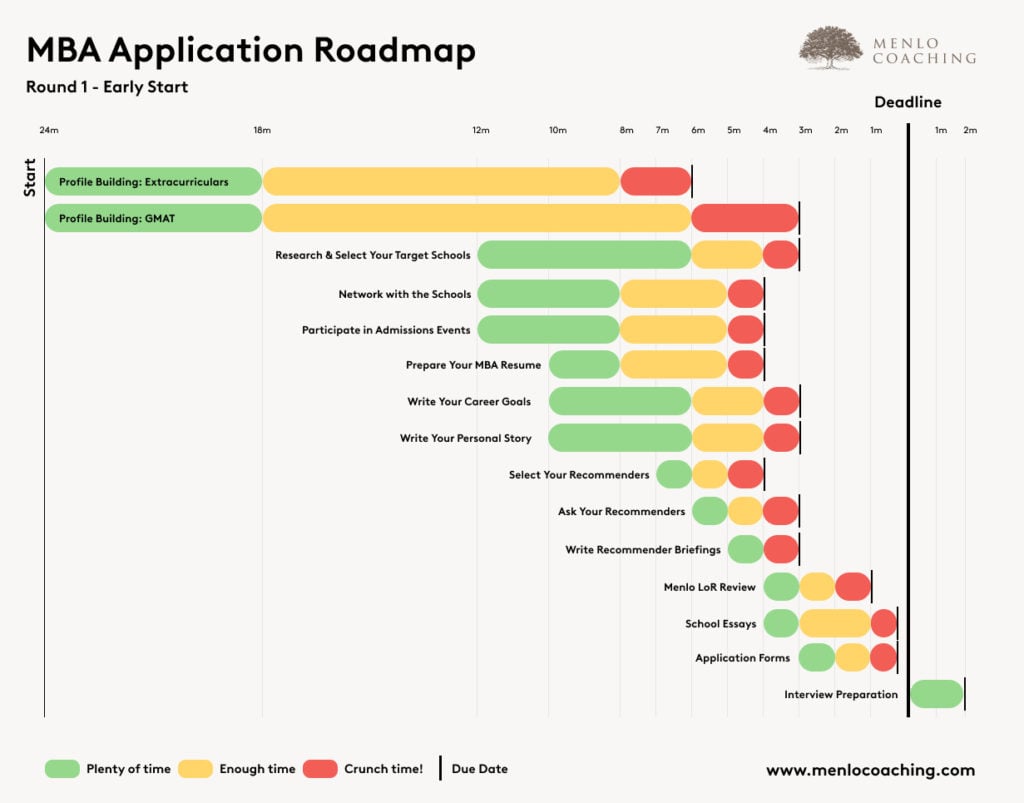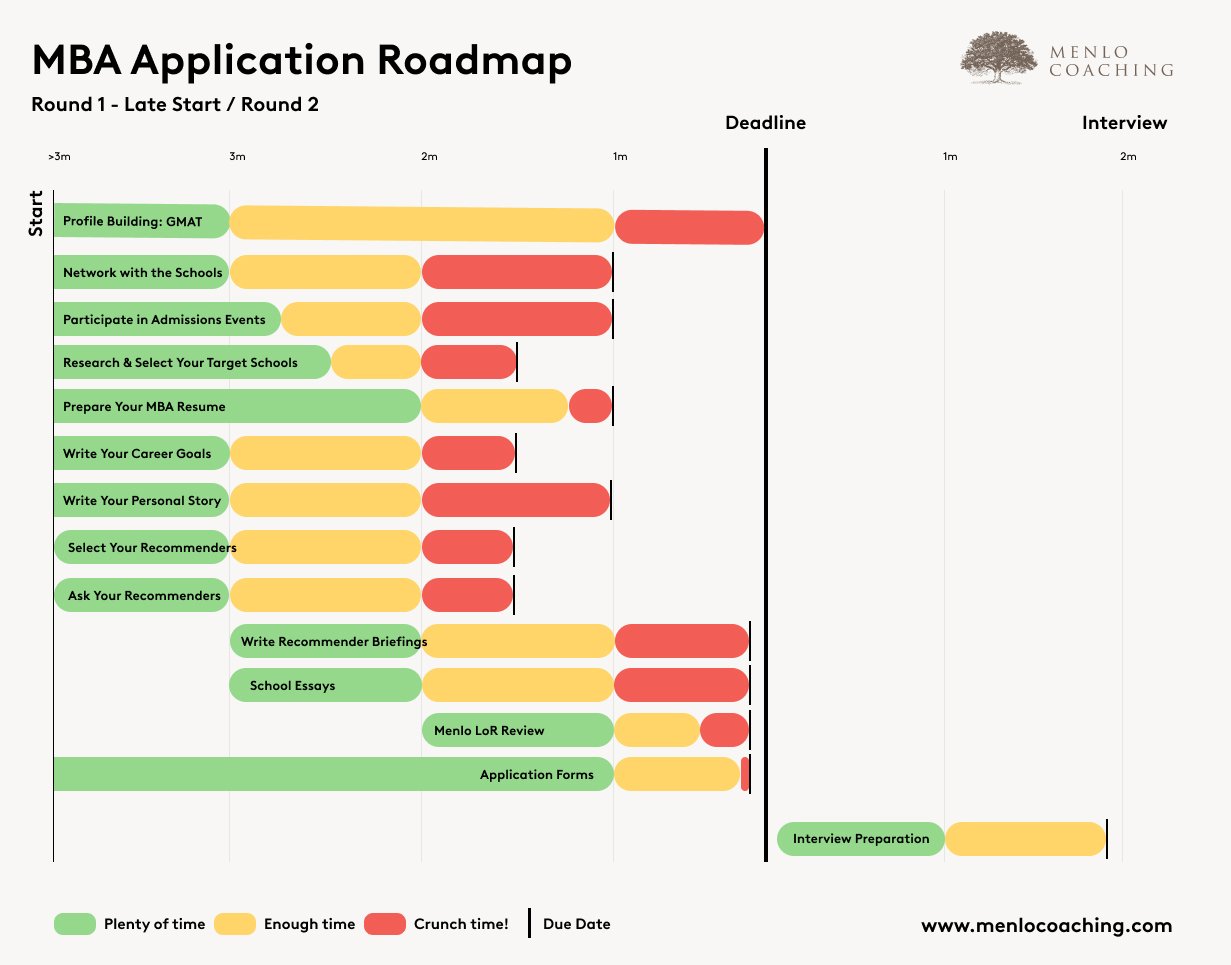Physical Address
The staple for pretty much every MBA application is the “career goals essay.” In one form or another, almost every single program asks for one of these types of essays. Tackle your “goals essay” first – and early – to give you time to adapt it to different programs. Review our comprehensive career goals essay guide to knock this seminal portion of your application out of the park.
MBA Application Timeline: What to Do and When to Do It
The MBA admissions timeline can be confusing, so we’ve created a clear and easy-to-follow “roadmap” to help you understand what to do and when to do it. Whether you’re applying to one, three, or ten business schools, follow this timeline for efficient preparation and to ensure you are getting everything done in the optimal order! Roughly, here are the main groups of tasks:
Steps for the MBA Admissions Process
- Profile Building: Extracurriculars and GMAT
- School selection and networking
- Written application items: Resume, career goals, personal story
- Recommendation letters
- School-specific essays and application forms
- Interview preparation


Core MBA Application Timeline
The core application process should start in earnest about ten months before the application deadline. Our experience has shown that the MBA timeline presented above is a reliable benchmark for those applying to business school. Working backwards from the school-specific application deadline, you can plan out all the important steps and even determine specific dates for when to have those items complete. Please note: this is a general guideline and you must consider the application steps with your specific needs in mind.
Deadlines and Rounds
Before we break down the MBA application timeline and its tasks, let’s have a quick look at the MBA application deadlines themselves and the various MBA application rounds. Deadlines are usually announced well in advance, but if a business school has yet to release deadlines for the current year, it is a reasonable assumption that they will be the same or similar to deadlines in years past.
There are usually three rounds of applications for MBA admissions, and generally, we advise applicants to apply in the first round. This is especially true if you are in an over-represented demographic. Some people think that the second and/or third rounds will be less stressful than the first, but this is not the case.
What Tasks to Do When
Early Preparation
Before you sit down to write your MBA applications and begin your business school admissions journey, it is beneficial if you take some preparatory steps. An MBA application can take years of effort when you consider all that comes into play: workplace experience, extracurriculars, networking, and more. On top of that, you need to secure a strong GMAT score, which can take many months (if not years) for some people. Our advice is to get tutoring or join a GMAT prep course as professional help is the most efficient way to improve your score!
Broadly speaking, MBA programs want applicants to have four or five years of work experience. This is to ensure a higher quality of education and help secure post-MBA job placement. However, this is not a firm rule and exceptions can be made.
Prior to applying you will need to have a good idea of which school(s) you wish to attend. Visit business schools and research their program offerings before applying. We’ve created a useful resource showcasing overviews of several top business schools to help you get started. If possible, network and participate in MBA admissions events at the school(s) you are interested in.
This is also an excellent time to identify people who can write letters of recommendation. Letters of recommendation can be tricky, and if you have fallen out of touch with a potential recommender you will need to reconnect with them sooner rather than later. While a business school application timeline is long, and it may be discouraging to realize how much work needs to be done before the core application can begin, having all these pieces in place will ease the way into an MBA program.
After these early preparation steps, then you need to develop your career goals, produce your MBA resume and other supporting documents, and write strong application essays. Let’s dig into those.
Written Application Items
Essays & Resume
A crucial step in the core process will be to develop your personal story and career goals. It is very common for applicants to struggle with this step.
At this stage you will also create a resume specifically for your MBA application. This is good to have early on in the process and will help with networking or early interviews. This may seem like a quick and easy task, but since so much important information needs to be conveyed in such a short document this can take longer than expected.
Letters of Recommendation
During the personal development stage you will need to start identifying and cultivating your recommenders (if you have not already done so in the early MBA application process). As previously mentioned, this can be a tricky task. Recommenders are usually very busy people, and getting a recommendation letter in your hands before the deadline can be a challenge.
To this end, it is very important that you clearly communicate with your recommenders. Reaching out to a recommender well in advance can also give you the opportunity to strengthen your relationship with them. We recommend that you connect with your recommender at least six months before the school’s deadline.
Once the application has been submitted you can then focus on preparing for the MBA interviews—you can read our MBA interview guides to get a sense of the questions you might encounter during your interviews. And of course, don’t forget to factor in a little relaxation after all your hard work!
The MBA application process can be long and difficult, but the right plan of action—and when possible, the assistance of an MBA admissions consultant—can help you avoid unnecessary stress. Our timeline lays out all the steps for an MBA applicant to follow so that they know what needs to be done, when it needs to be done.
Menlo Coaching can help you stay on schedule through the admissions process
If you’re interested in receiving personalized guidance through the MBA timeline, apply to work with Menlo Coaching.
The Ideal MBA Application Timeline
Decide whether to apply round 1 vs round 2 and learn how to maximize your odds of getting accepted

Applying to business school can feel like a full-time job on top of what’s sure to be an already jam-packed schedule for you. From writing the essays to acing the GMAT, you need a clear plan for how to tackle the many facets of this application process.
Below, you’ll find a general guide for the MBA admissions season and suggestions regarding what you can be doing at any given stage to help you prepare to meet your program-of-choice’s deadlines.
Before we lay out the timeline, take a moment to consider which MBA application round is best suited for you.
Why do MBA programs have several rounds?
The majority of business schools offer three rounds of admissions (some, notably Harvard and Columbia, offer only two rounds.)
The purpose of these rounds is twofold:
1.) Multiple rounds give you, the applicant, the opportunity to diversify the type and number of programs you can apply to in the case of being rejected in round one from your first-choice program.
2.) These rounds give programs the ability to review applicants in a more thorough manner than they would be able to if all applications poured in at once.
As a general rule, you should apply to your top-choice programs in the earlier rounds and your safer bets in the later rounds.
Round 1 vs Round 2 vs Round 3
Round 1
Round 1, for nearly every MBA program, yields the highest probability for acceptance. Why? Round 1 almost always has the smallest batch of applicants—a lot of people don’t get it together in time—so acceptance percentages of course skew higher within a smaller pool. But it’s also often the case that the strongest applicants are the ones ready to apply by the earliest deadline.
Your competition in round 1 is tough, but if you’re ready with your application materials and are satisfied with your GMAT scores, you should apply to your top-choice programs in the first round.
First-round MBA application deadlines for top programs vary, but they begin on September 4 (Harvard) and run through early October.
Round 2
For programs offering 2 or 3 rounds, Round 2 consistently sees the largest batch of applicants. This fact makes your statistical chances for acceptance lower than they would be for Round 1, but don’t rely too heavily on statistics.
The amount of extra time you have between rounds 1 and 2 can mean wonders for the quality of your application, and if your application is significantly better for having waited for the second round rather than rushing to meet the first, then it behooves you to wait it out.
Common reasons for waiting for round 2 include unsatisfactory GMAT scores that require a re-test and application essays that need further work. Both of these variables are solid ground for applying in Round 2.
Round 2 deadlines range from October to January, with most programs falling just after the new year.
Round 3
Round 3 is a tough sell. For top-10 programs, the majority of acceptances are awarded to round 1 and 2 applicants. Lower ranked programs receive a flood of round 3 applicants who didn’t make the cut for top program’s earlier rounds. No matter how you look at it, applying in the third round yields your slightest shot at getting accepted to an MBA.
If you’re a current college senior applying to 2-for-2 programs or MBAs straight out of the gate, programs may advise you to wait to apply until round 3 so your college transcript is more fully fleshed out, but if you’re a professional applying to business school (as most MBA applicants are) then waiting until the final round of admissions should be reserved for last resort efforts.
Round 3 deadlines vary greatly. Though the vast majority of programs’ round 3 deadlines occur in late March and early April, some programs (like NYU and Duke) have round 3 deadlines in January.
It’s worth noting that most programs with earlier round 3 deadlines also offer a round 4 deadline around February and March. Our advice for 4-round programs remains consistent with 3-round programs: apply to your top-choice schools in the earliest possible rounds and work your way down your preference list in chronological order.
MBA Application Timeline
The summer before the application cycle starts
Step 1: GMAT
It’s widely recommended that you take your GMAT at least two months before a given round’s application deadline so that your scores can be reported to the program. But if you’re aiming for a round 1 application, you’ll want to take your GMAT even earlier–the summer prior to your application cycle–in order to best figure out what your possible options are in regard to school rankings. Study, test, and leave yourself enough time to re-test in the event the first attempt goes awry.
Step 2: Learn about the program
Assuming you’ve already decided to apply to MBA programs and your GMAT went as expected, the summer before the application cycle begins provides an excellent time to narrow down your list of programs and become more acquainted with their offerings, culture, and how you can grow while there.
If you’re able, arrange for a campus visit. Campus visits provide you a wealth of knowledge about all a program has to offer that far exceeds what you can find on a program’s website. While there, coordinate with the admissions office to see if you can sit in on classes, meet fellow students, or talk with an admissions rep about the program.
The more you know about the program, and the more you can exhibit this knowledge in your application essays, and the more seriously the MBA admissions committee will consider your application. Readers want to believe their program is your first choice, and the best way to communicate this is being hyper familiar with what you can gain from that school’s MBA and how you can contribute to campus life.
Step 3: Tap into your network
In line with gathering information, tap into your professional network to figure out if anyone you may know attended that program. Use them as resources for learning more and hearing any application tips they may have. Understanding the future impact of a program’s alumni network can go a long way toward arguing why a program is right for your professional trajectory.
Step 4: Identify recommenders
Most MBA programs require 2-3 recommendation letters from people who know you and your work. More often than not, these recommendations will come from your immediate supervisors, but you can often choose one of the three recommenders out of someone from your past places of work, educational institutions, volunteer work, or even clients for whom you’ve done exceptional work.
Over the summer, decide who you’d like to recommend you and re-connect with them. ask if they would feel comfortable providing a “strong letter of recommendation.” If they seem hesitant, simply thank them and move on to the next. Better to suffer that minor rejection than end up with a weak LOR and lower admissions odds.
Step 5: Ready your resume
The resume is the centerpiece for every MBA application, and it will be the one common factor between all the different programs. While your essays will differ between applications, your resume is shining beacon that guides your applications. Start working on that way ahead of time so you can focus your fall efforts on the applications themselves.
Application Season
Step 6: Get organized
With the deadlines now looming, it’s time to get organized. Construct a plan. What are your three top-choice programs? What are your three safer options? Plan to apply to your top-choice schools in Round 1 and, if necessary, your lower choice programs in later rounds. Make a to-do list including the essay prompts of your top schools and start preparing your answers.
Step 7: Career Goals essay
The staple for pretty much every MBA application is the “career goals essay.” In one form or another, almost every single program asks for one of these types of essays. Tackle your “goals essay” first – and early – to give you time to adapt it to different programs. Review our comprehensive career goals essay guide to knock this seminal portion of your application out of the park.
Step 8: Essay packets
In addition to the “goals essay,” you’ll find that each application asks for a series of shorter, more pointed essays. Failure essays, campus life essays, short-answer questions, etc. Once your resume and goals essay are finished, dive into the specific application questions starting with your top-choice schools.
Step 9: Apply
Assemble all your materials, send out your transcripts, check to make sure your recommendations are in line, and click the send button.
Step 10: Prepare for your interviews
Most programs offer interviews on an invitation basis. If they liked your application enough, you’ll be amongst the 20-40% of applicants who receive an invitation to interview. This is the final hurdle before gaining admission to your top-choice school.
After completing these steps, all that’s left to do is wait. If you receive rejections from your Round 1 applications, never fear. Repeat this process for your lower-ranked programs to meet their second- and third-round deadlines.
Last-minute MBA applications
Though we advise getting an early start when preparing for your MBA applications, if you’re a working professional, time is often not your friend. If it’s fall and you’ve just decided to apply to business schools, you can condense the ten steps above into something manageable for your abbreviated timeline. Still shoot for round two, or ~January.
- Resume—ace by the end of November
- GMAT—you’ll need to have taken this and earned a score you’re happy with by the first week of December
- Career Goals Essay—finish this by mid-December
- Program-specific Essays—get through these by the New Year
You may not have time for campus visits, information-gathering networking, and recommender relationship building, but these are all secondary concerns to what matters most to an MBA admissions committee: YOU. If you’re a shining star bound to lead the future of business, the admissions committee might not mind that you don’t know every last detail about their campus or that your recommendations seem a bit impersonal.
Ultimately, they’re admitting you for your leadership potential, and that outweighs deadlines.









